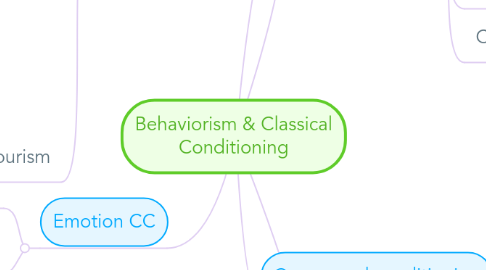
1. Behaviorism roots
1.1. Logical positivism -Verificationism -Mental concepts refer to behavioural tendencies Translate mental concepts into overt behaviour
1.2. Association -Associate things & events that occur together
1.2.1. Law of contiguity -things occur in same space & time ex: bed & cockroach
1.2.2. Law of similarity -apple & orange
1.2.3. Law of contrast - opposite ex:black & white
1.2.4. Law of frequency -reoccurring pairings -thunder & lightning
1.3. John B. Watson was the ‘father of behaviourism
2. Emotion CC
2.1. Conditioned emotional response CES
2.1.1. Seeing ball + pinch -> fear
2.2. Conditioned supression
2.2.1. images of hurting ppl + pain -> reduce bad behaviour
3. Modern research/theory
3.1. Dual-process conditioning
3.1.1. Implicit(heart rate) vs Explicit knowledge/learning -explicit is not needed for conditioning
4. Phenomena
4.1. Extinction
4.2. Renewal
4.2.1. ABA renewal ex: clinical situation-> real life
4.3. Spontaneous Recovery
4.3.1. Extinct behavioury re-emerges after period of rest -associated has not been forgotten
4.4. Generalization
4.4.1. cocacola-> happy, other soda -> also happy
4.5. Discrimination
4.5.1. Only responding to specific stimuli and not others
4.6. Backward Conditioning
4.6.1. bell after food is presented
4.7. Counter-conditioning
4.7.1. Phobia therapy
5. Compound conditioning
5.1. more than 1 CS
5.2. Over-shadowing
5.2.1. Conditioning stronger for one CS from the compound
5.3. Blocking procedure
5.3.1. 1. CS1 + US-> UR 2. CS1-> CR 3. Add CS2 into it 4. Test separately
5.3.2. CS1 elicits stronger response (CR)
5.3.3. CS1/US association has blocked formation of CS2/US association
5.3.4. Backward blocking -CS1 + CS2 + US -> UR Remove CS2: CS1 + US -> UR Test CS1 and CS2 separately
5.4. Higher-order conditioning
5.4.1. use CS as US
5.4.2. CS1 + US -> UR CS1 -> CR CS1 + CS2 (no US) -> CR (Using CS1 as the US) CS2 alone -> CR
